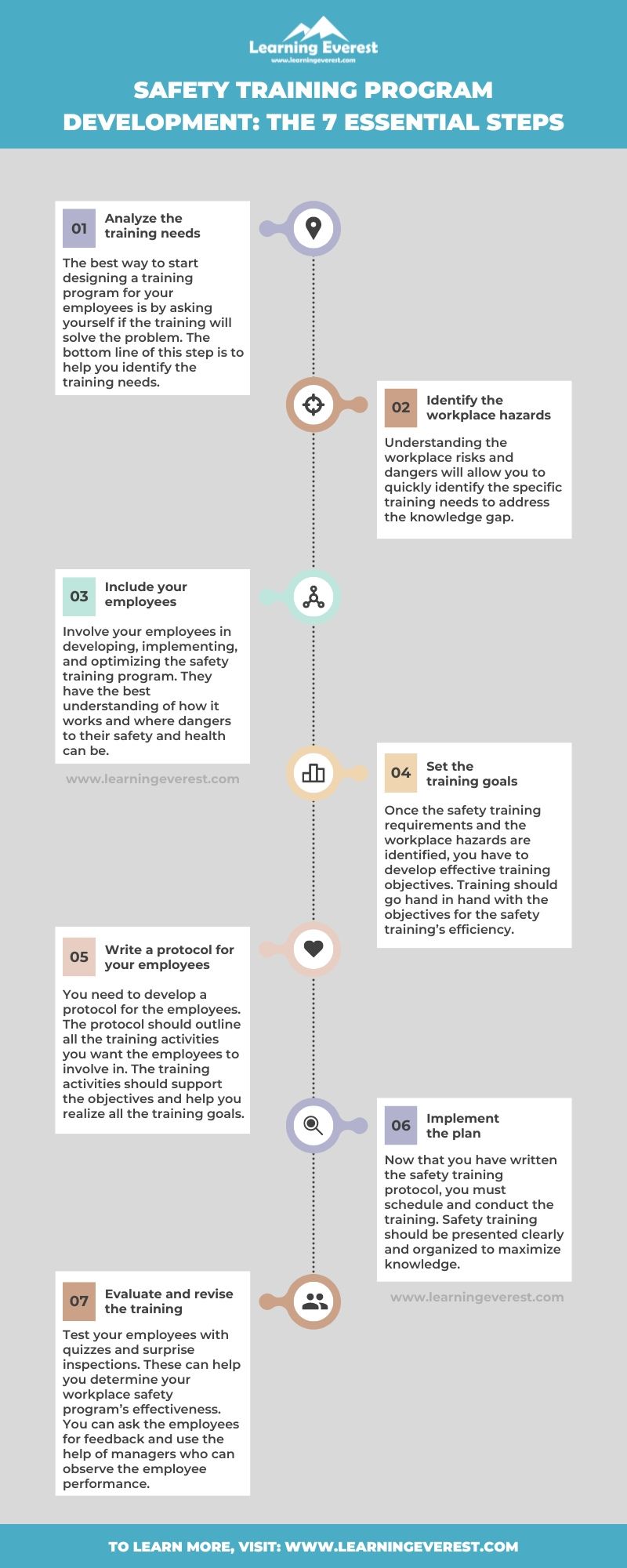Hazards are pervasive in every organization. Hence it is essential for organizations to make provisions for safety training programs for their employees and to update the safety norms regularly. A workplace safety training program is as vital as workplace safety itself.
Table of Contents
Here are 7 effective steps to get you started on how to develop a workplace safety training program for your employees:
1. Analyze your training needs
The best way to start designing a training program for your employees is by asking yourself if the training will solve the problem. The bottom line of this step is to help you identify the training needs. One of the easy ways to identify such needs is by checking the current organizational safety record. This means that you must determine whether the problem stems from employee performance in the workplace. In this case, safety training will be more effective when the problem is how your employees are performing.
2. Identify the workplace risks and hazards
Your safety training program will only be effective if you know the workplace risks and hazards. Understanding the workplace risks and dangers will allow you to quickly identify the specific training needs to address the knowledge gap. You can achieve this by adequately assessing daily hazards and risks in your workplace. You should also allow employees to express their risk concerns, as their opinion matters greatly.
Since the employees work in these conditions daily, they can give essential insights about a risk that may not be obvious to the untrained eye. You will also want to analyze other possible safety hazards that may emerge along the way. However, you must distinguish workplace risks like building layout from machinery-related and environmental hazards. This will ensure that you develop an appropriate safety training program to instil a proper safety culture among your employees.
3. Include your employees
Involve your employees in developing, implementing, and optimizing the safety training program. The contribution of managers, supervisors, and employees is crucial. They have the best understanding of how it works and where dangers to their safety and health can be. Create training and testing modules that can be applied to each role in the organization according to regulations. Train the managers and supervisors in the safety requirements of their teams. This will help them to identify issues with employee compliance with safety regulations. Include communication channels for hazard reporting in your training so employees know whom to contact and how to prevent a potential accident.
4. Set the training goals
Once the safety training requirements and the workplace hazards are identified, you have to develop effective training objectives. Training should go hand in hand with the objectives for the safety training’s efficiency. The training objectives are what you want the employees to do while at work after the training. The objectives can be related to skill, awareness, behavior, or even procedure. So, you need to develop effective training objectives, which must be relevant and measurable. This ensures that you can evaluate and revise the training later. Detailed safety training objectives can help you and the employees understand the expected outcomes.
5. Write a protocol for your employees
You need to develop a protocol for the employees. The protocol should outline all the training activities you want the employees to involve in. The training activities should support the objectives and help you realize all the training goals. Your protocol should also include the training methods, materials, and resources needed for effective workplace safety training. When choosing the materials, resources, and techniques, you must select the best. It will ensure that the training conveys the message effectively.
6. Implement the plan
Now that you have written the safety training protocol, you must schedule and conduct the training. Safety training should be presented clearly and organized to maximize knowledge. Ideally, you should start by providing the employees with a training overview to know what to expect. The training should also be related to the employee’s daily experience for relevance and application. After you have conducted the safety training program, follow it up by emphasizing the lessons learned. If you need help keeping the employees motivated and interested in training, you can participate and practice their newly acquired skills during the training. Moreover, provides continuous and easy access to safety training content to let employees refresh their memory when necessary.
7. Evaluate and revise the training
A safety training program can only be successful if employees learn from it and achieve its objectives. Test your employees with quizzes and surprise inspections. These can help you determine your workplace safety program’s effectiveness before an accident forces you to discover it is not. So, the last thing is to form a policy evaluating the training, as you cannot know about its success without evaluation. You can ask the employees for feedback and use the help of managers who can observe the employee performance before and after the training program. The results obtained from the evaluation will further help you know how to exceed the safety training program.
Now that we have discussed how to develop a safety training program effectively, we hope it will help your organization’s safety training journey. We will love to hear your comments below if you have any questions or suggestions on effectively conducting a safety training program!
Infographic

Safety Training Program Development The 7 Essential Steps
Knowledge Check!
Frequently Asked Questions (FAQs)
Why safety training program is important?
Hazards are pervasive in every organization. Hence it is essential for organizations to make provisions for safety training programs for their employees and to update the safety norms regularly.
What are the three types of safety?
There are three types of safety: physical, emotional, and financial.
How do we create effective safety training programs?
Your safety training program will only be effective if you know the workplace risks and hazards. Understanding the workplace risks and dangers will allow you to quickly identify the specific training needs to address the knowledge gap.





